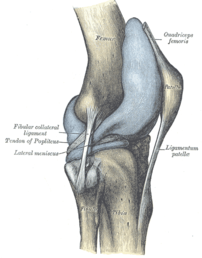[amazon_link asins=’B013MML2BI,B00L5G82D0′ template=’ProductCarousel’ store=’finmeacur-20′ marketplace=’US’ link_id=’0c9777c9-f338-11e6-a2ee-afc116e0d076′]
[amazon_link asins=’B003VMAKVS,0897934229′ template=’ProductCarousel’ store=’finmeacur-20′ marketplace=’US’ link_id=’8d76cc86-f338-11e6-aa41-134e6d335e49′]
The knees are one of the larger joints in the body, supporting its entire weight. It is a hinge joint, like that of a door, capable only of moving forwards and backwards. Attempts to force a door to move sideways or push it open in the wrong direction will result in the door “coming off its hinges.” A similar problem occurs when the knee is forced to move in the wrong direction.
The knee joint is composed of three bones, the lower end of the femur and the upper ends of the tibia and fibula, articulating with one another. The raw bones do not grate against each other. They are separated by a “joint space” filled with synovial fluid, lined with articulating cartilage and separated by little washers called meniscii. There are ligaments inside the joint holding it in place. Considering the size of the knee joint, these ligaments are woefully inadequate. In the front of the knee is the kneecap or patella.
Click & see: Anatomy of knee :
The knee undergoes constant wear and tear. Our daily activities involve walking and climbing stairs as well as exercising. In a lifetime, the knee joint functions over and above its capacity!
The knee undergoes constant wear and tear. Our daily activities involve walking and climbing stairs as well as exercising. In a lifetime, the knee joint functions over and above its capacity!
Pain in the joint can be acute and occurs owing to injury, infection, or age-(or overuse) related degeneration. The cartilage breaks down, exposing parts of the bone underneath. The raw nerves are exposed and this becomes very painful. Bits of broken cartilage can get trapped in the joint. When that occurs, movement can result is sudden pain and the joint can get locked.
Dislocations and injuries are more common in the young — basketball and football are notorious for causing knee injuries. This is because there are sudden abrupt changes in the direction of movement, which may be against the normal anatomical direction of movement. The player may land awkwardly or fall, bruising and injuring the joint.
The two knees support the weight of the entire body between them. The bones are physically capable of supporting only a certain amount of weight. Obesity causes the knees to degenerate rapidly. Depending on gait and posture, one side may wear out faster than the other. This may result in a bow-legged appearance. Walking is extremely painful and the gait may be crab like. The entire joint may be swollen and painful. Or, the pain may be localised on one side. At times, instead of the whole joint, the area under the patella gets worn down and irregular. As that rubs against the bones underneath, there is terrible pain with movement.
Children seldom develop knee pain without injury or a fracture. Boys can develop pain as part of certain inherited congenital syndromes or birth defects in the knee. The patella may also get dislocated. This is more common in teenage girls.
Infections, acute trauma and fractures result in swollen, warm and tender joints. Arthritis, especially rheumatoid or osteoarthritis, can produce a similar picture. Infection always produces fever. Gout usually affects the big toe but can present itself as a painful knee joint. It may be worth checking uric acid levels.
CLICK & SEE:
Ayurvedic remedies of knee pain
Ayurvedic Therapy – A Promising Treatment for Knee Osteoarthritis?
Natural Ayurvedic Home Remedies for Knee Pain
Ayurveda for Osteo Arthritis (Knee Joint Pain)
Knee Injury Treatment With Six Homeopathic Medicines
Source: The Telegraph (Kolkata, Indi













![Reblog this post [with Zemanta]](https://i0.wp.com/img.zemanta.com/reblog_e.png?w=580)